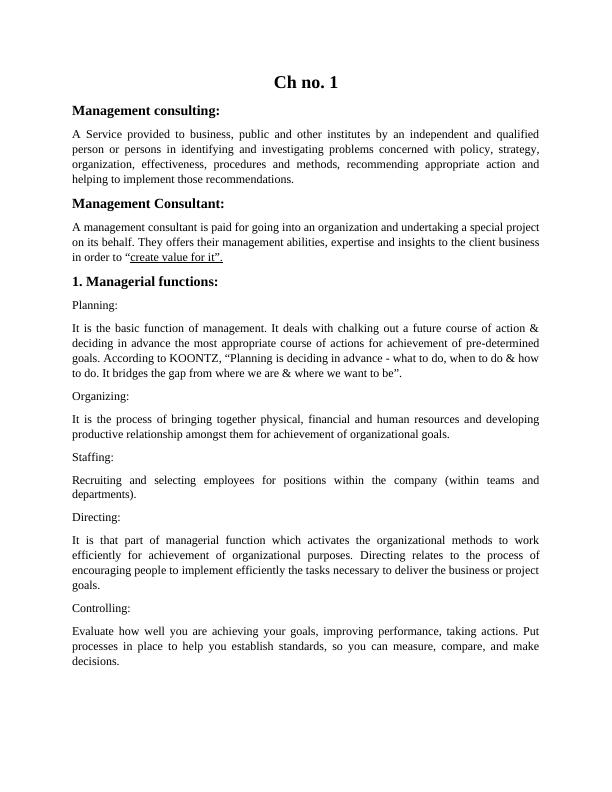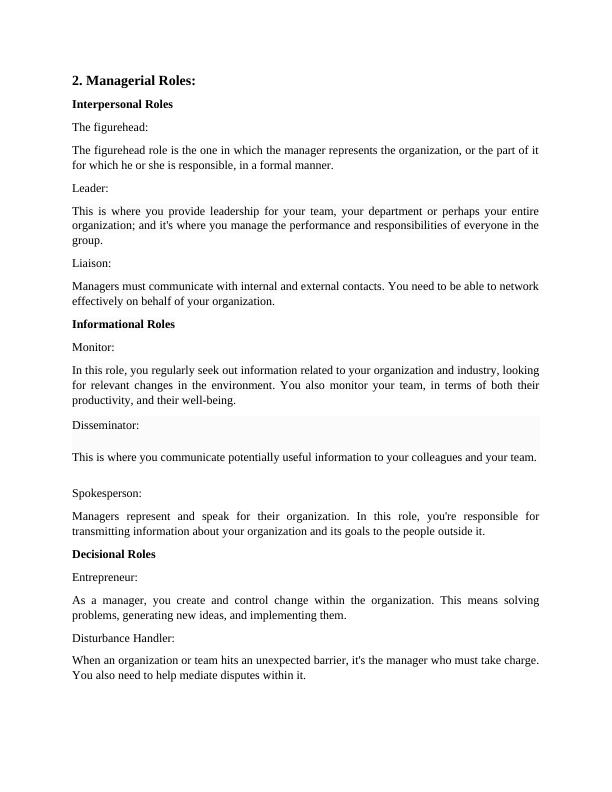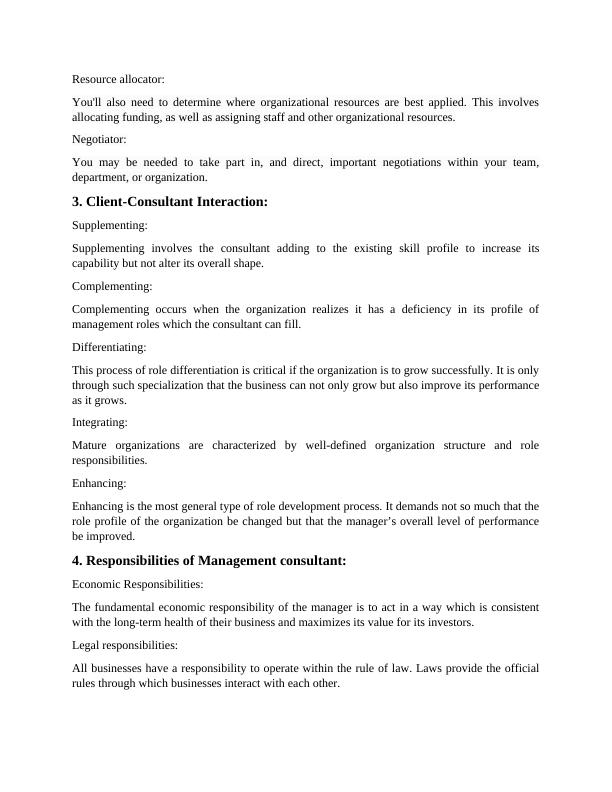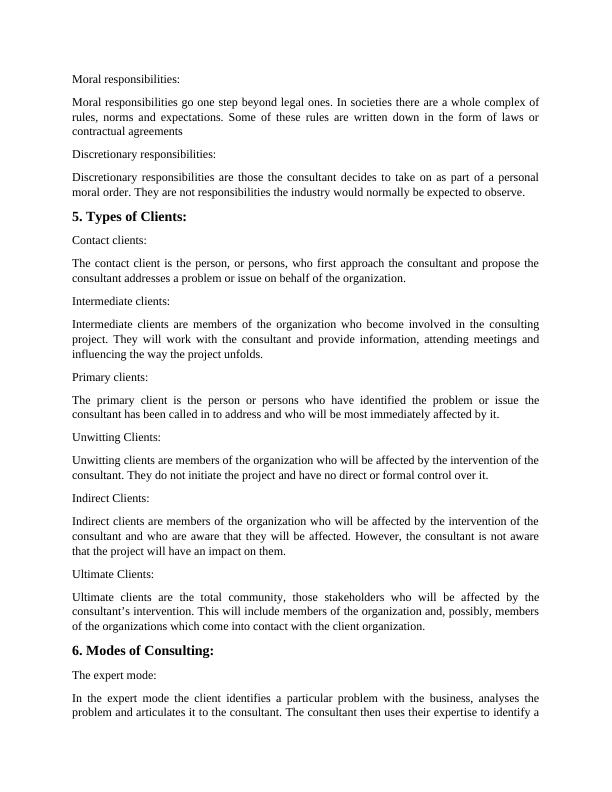Management consulting, Services and Responsibilities
Added on 2023-05-04
14 Pages3860 Words109 Views
Ch no. 1
Management consulting:
A Service provided to business, public and other institutes by an independent and qualified
person or persons in identifying and investigating problems concerned with policy, strategy,
organization, effectiveness, procedures and methods, recommending appropriate action and
helping to implement those recommendations.
Management Consultant:
A management consultant is paid for going into an organization and undertaking a special project
on its behalf. They offers their management abilities, expertise and insights to the client business
in order to “create value for it”.
1. Managerial functions:
Planning:
It is the basic function of management. It deals with chalking out a future course of action &
deciding in advance the most appropriate course of actions for achievement of pre-determined
goals. According to KOONTZ, “Planning is deciding in advance - what to do, when to do & how
to do. It bridges the gap from where we are & where we want to be”.
Organizing:
It is the process of bringing together physical, financial and human resources and developing
productive relationship amongst them for achievement of organizational goals.
Staffing:
Recruiting and selecting employees for positions within the company (within teams and
departments).
Directing:
It is that part of managerial function which activates the organizational methods to work
efficiently for achievement of organizational purposes. Directing relates to the process of
encouraging people to implement efficiently the tasks necessary to deliver the business or project
goals.
Controlling:
Evaluate how well you are achieving your goals, improving performance, taking actions. Put
processes in place to help you establish standards, so you can measure, compare, and make
decisions.
Management consulting:
A Service provided to business, public and other institutes by an independent and qualified
person or persons in identifying and investigating problems concerned with policy, strategy,
organization, effectiveness, procedures and methods, recommending appropriate action and
helping to implement those recommendations.
Management Consultant:
A management consultant is paid for going into an organization and undertaking a special project
on its behalf. They offers their management abilities, expertise and insights to the client business
in order to “create value for it”.
1. Managerial functions:
Planning:
It is the basic function of management. It deals with chalking out a future course of action &
deciding in advance the most appropriate course of actions for achievement of pre-determined
goals. According to KOONTZ, “Planning is deciding in advance - what to do, when to do & how
to do. It bridges the gap from where we are & where we want to be”.
Organizing:
It is the process of bringing together physical, financial and human resources and developing
productive relationship amongst them for achievement of organizational goals.
Staffing:
Recruiting and selecting employees for positions within the company (within teams and
departments).
Directing:
It is that part of managerial function which activates the organizational methods to work
efficiently for achievement of organizational purposes. Directing relates to the process of
encouraging people to implement efficiently the tasks necessary to deliver the business or project
goals.
Controlling:
Evaluate how well you are achieving your goals, improving performance, taking actions. Put
processes in place to help you establish standards, so you can measure, compare, and make
decisions.

2. Managerial Roles:
Interpersonal Roles
The figurehead:
The figurehead role is the one in which the manager represents the organization, or the part of it
for which he or she is responsible, in a formal manner.
Leader:
This is where you provide leadership for your team, your department or perhaps your entire
organization; and it's where you manage the performance and responsibilities of everyone in the
group.
Liaison:
Managers must communicate with internal and external contacts. You need to be able to network
effectively on behalf of your organization.
Informational Roles
Monitor:
In this role, you regularly seek out information related to your organization and industry, looking
for relevant changes in the environment. You also monitor your team, in terms of both their
productivity, and their well-being.
Disseminator:
This is where you communicate potentially useful information to your colleagues and your team.
Spokesperson:
Managers represent and speak for their organization. In this role, you're responsible for
transmitting information about your organization and its goals to the people outside it.
Decisional Roles
Entrepreneur:
As a manager, you create and control change within the organization. This means solving
problems, generating new ideas, and implementing them.
Disturbance Handler:
When an organization or team hits an unexpected barrier, it's the manager who must take charge.
You also need to help mediate disputes within it.
Interpersonal Roles
The figurehead:
The figurehead role is the one in which the manager represents the organization, or the part of it
for which he or she is responsible, in a formal manner.
Leader:
This is where you provide leadership for your team, your department or perhaps your entire
organization; and it's where you manage the performance and responsibilities of everyone in the
group.
Liaison:
Managers must communicate with internal and external contacts. You need to be able to network
effectively on behalf of your organization.
Informational Roles
Monitor:
In this role, you regularly seek out information related to your organization and industry, looking
for relevant changes in the environment. You also monitor your team, in terms of both their
productivity, and their well-being.
Disseminator:
This is where you communicate potentially useful information to your colleagues and your team.
Spokesperson:
Managers represent and speak for their organization. In this role, you're responsible for
transmitting information about your organization and its goals to the people outside it.
Decisional Roles
Entrepreneur:
As a manager, you create and control change within the organization. This means solving
problems, generating new ideas, and implementing them.
Disturbance Handler:
When an organization or team hits an unexpected barrier, it's the manager who must take charge.
You also need to help mediate disputes within it.

Resource allocator:
You'll also need to determine where organizational resources are best applied. This involves
allocating funding, as well as assigning staff and other organizational resources.
Negotiator:
You may be needed to take part in, and direct, important negotiations within your team,
department, or organization.
3. Client-Consultant Interaction:
Supplementing:
Supplementing involves the consultant adding to the existing skill profile to increase its
capability but not alter its overall shape.
Complementing:
Complementing occurs when the organization realizes it has a deficiency in its profile of
management roles which the consultant can fill.
Differentiating:
This process of role differentiation is critical if the organization is to grow successfully. It is only
through such specialization that the business can not only grow but also improve its performance
as it grows.
Integrating:
Mature organizations are characterized by well-defined organization structure and role
responsibilities.
Enhancing:
Enhancing is the most general type of role development process. It demands not so much that the
role profile of the organization be changed but that the manager’s overall level of performance
be improved.
4. Responsibilities of Management consultant:
Economic Responsibilities:
The fundamental economic responsibility of the manager is to act in a way which is consistent
with the long-term health of their business and maximizes its value for its investors.
Legal responsibilities:
All businesses have a responsibility to operate within the rule of law. Laws provide the official
rules through which businesses interact with each other.
You'll also need to determine where organizational resources are best applied. This involves
allocating funding, as well as assigning staff and other organizational resources.
Negotiator:
You may be needed to take part in, and direct, important negotiations within your team,
department, or organization.
3. Client-Consultant Interaction:
Supplementing:
Supplementing involves the consultant adding to the existing skill profile to increase its
capability but not alter its overall shape.
Complementing:
Complementing occurs when the organization realizes it has a deficiency in its profile of
management roles which the consultant can fill.
Differentiating:
This process of role differentiation is critical if the organization is to grow successfully. It is only
through such specialization that the business can not only grow but also improve its performance
as it grows.
Integrating:
Mature organizations are characterized by well-defined organization structure and role
responsibilities.
Enhancing:
Enhancing is the most general type of role development process. It demands not so much that the
role profile of the organization be changed but that the manager’s overall level of performance
be improved.
4. Responsibilities of Management consultant:
Economic Responsibilities:
The fundamental economic responsibility of the manager is to act in a way which is consistent
with the long-term health of their business and maximizes its value for its investors.
Legal responsibilities:
All businesses have a responsibility to operate within the rule of law. Laws provide the official
rules through which businesses interact with each other.

Moral responsibilities:
Moral responsibilities go one step beyond legal ones. In societies there are a whole complex of
rules, norms and expectations. Some of these rules are written down in the form of laws or
contractual agreements
Discretionary responsibilities:
Discretionary responsibilities are those the consultant decides to take on as part of a personal
moral order. They are not responsibilities the industry would normally be expected to observe.
5. Types of Clients:
Contact clients:
The contact client is the person, or persons, who first approach the consultant and propose the
consultant addresses a problem or issue on behalf of the organization.
Intermediate clients:
Intermediate clients are members of the organization who become involved in the consulting
project. They will work with the consultant and provide information, attending meetings and
influencing the way the project unfolds.
Primary clients:
The primary client is the person or persons who have identified the problem or issue the
consultant has been called in to address and who will be most immediately affected by it.
Unwitting Clients:
Unwitting clients are members of the organization who will be affected by the intervention of the
consultant. They do not initiate the project and have no direct or formal control over it.
Indirect Clients:
Indirect clients are members of the organization who will be affected by the intervention of the
consultant and who are aware that they will be affected. However, the consultant is not aware
that the project will have an impact on them.
Ultimate Clients:
Ultimate clients are the total community, those stakeholders who will be affected by the
consultant’s intervention. This will include members of the organization and, possibly, members
of the organizations which come into contact with the client organization.
6. Modes of Consulting:
The expert mode:
In the expert mode the client identifies a particular problem with the business, analyses the
problem and articulates it to the consultant. The consultant then uses their expertise to identify a
Moral responsibilities go one step beyond legal ones. In societies there are a whole complex of
rules, norms and expectations. Some of these rules are written down in the form of laws or
contractual agreements
Discretionary responsibilities:
Discretionary responsibilities are those the consultant decides to take on as part of a personal
moral order. They are not responsibilities the industry would normally be expected to observe.
5. Types of Clients:
Contact clients:
The contact client is the person, or persons, who first approach the consultant and propose the
consultant addresses a problem or issue on behalf of the organization.
Intermediate clients:
Intermediate clients are members of the organization who become involved in the consulting
project. They will work with the consultant and provide information, attending meetings and
influencing the way the project unfolds.
Primary clients:
The primary client is the person or persons who have identified the problem or issue the
consultant has been called in to address and who will be most immediately affected by it.
Unwitting Clients:
Unwitting clients are members of the organization who will be affected by the intervention of the
consultant. They do not initiate the project and have no direct or formal control over it.
Indirect Clients:
Indirect clients are members of the organization who will be affected by the intervention of the
consultant and who are aware that they will be affected. However, the consultant is not aware
that the project will have an impact on them.
Ultimate Clients:
Ultimate clients are the total community, those stakeholders who will be affected by the
consultant’s intervention. This will include members of the organization and, possibly, members
of the organizations which come into contact with the client organization.
6. Modes of Consulting:
The expert mode:
In the expert mode the client identifies a particular problem with the business, analyses the
problem and articulates it to the consultant. The consultant then uses their expertise to identify a

End of preview
Want to access all the pages? Upload your documents or become a member.
Related Documents
(HTM 264) - Management and Organizational Behavior: BSc Hospitality and Tourism Management (HTM)lg...
|4
|782
|413
Organisational Theory and Practicelg...
|13
|3998
|126
Managing People in Aviation IIlg...
|9
|1754
|88
Management and Operations of Nestle Limitedlg...
|20
|4669
|2558
Leading as a General Manager Case Study 2022lg...
|5
|831
|11
MCD2040 - Management Assignmentlg...
|23
|6275
|34
